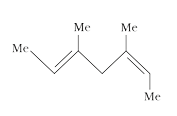Saturated hydrocarbon gas is evolved by carbide(s) is/are
CaC2
Al4C3
Mg2C3
Be2C
The correct Answer is:B, D
To determine which carbides evolve saturated hydrocarbon gas upon hydrolysis, we will analyze each option step by step.
Step 1: Understand what carbides are
Carbides are compounds composed of carbon and a less electronegative element. They can react with water to produce hydrocarbons.
Step 2: Analyze each carbide option
Option A: Calcium Carbide (CaC2)
- Reaction with water:
CaC2+2H2O→Ca(OH)2+HC≡CH
- Product: Acetylene (HC≡CH) is produced, which is an unsaturated hydrocarbon due to the triple bond.
Conclusion for A: Not a saturated hydrocarbon.
---
Option B: Aluminum Carbide (Al4C3)
- Reaction with water:
Al4C3+12H2O→4Al(OH)3+3CH4
- Product: Methane (CH4) is produced, which is a saturated hydrocarbon (no double or triple bonds).
Conclusion for B: This is a saturated hydrocarbon.
---
Option C: Magnesium Carbide (Mg2C3)
- Reaction with water:
Mg2C3+6H2O→2Mg(OH)2+3HC≡CCH3
- Product: Propine (HC≡CCH3) is produced, which is an unsaturated hydrocarbon due to the triple bond.
Conclusion for C: Not a saturated hydrocarbon.
---
Option D: Beryllium Carbide (Be2C)
- Reaction with water:
Be2C+4H2O→2Be(OH)2+CH4
- Product: Methane (CH4) is produced, which is a saturated hydrocarbon.
Conclusion for D: This is a saturated hydrocarbon.
Final Answer:
The carbides that evolve saturated hydrocarbon gas upon hydrolysis are:
- B. Al4C3
- D. Be2C
Carbides are compounds composed of carbon and a less electronegative element. They can react with water to produce hydrocarbons.
- Reaction with water:
CaC2+2H2O→Ca(OH)2+HC≡CH
- Product: Acetylene (HC≡CH) is produced, which is an unsaturated hydrocarbon due to the triple bond.
- Reaction with water:
Al4C3+12H2O→4Al(OH)3+3CH4
- Product: Methane (CH4) is produced, which is a saturated hydrocarbon (no double or triple bonds).
- Reaction with water:
Mg2C3+6H2O→2Mg(OH)2+3HC≡CCH3
- Product: Propine (HC≡CCH3) is produced, which is an unsaturated hydrocarbon due to the triple bond.
- Reaction with water:
Be2C+4H2O→2Be(OH)2+CH4
- Product: Methane (CH4) is produced, which is a saturated hydrocarbon.
The carbides that evolve saturated hydrocarbon gas upon hydrolysis are:
- B. Al4C3
- D. Be2C
Topper's Solved these Questions
- s-BLOCK ELEMENTSBOOK - VK JAISWAL ENGLISHCHAPTER - s-BLOCK ELEMENTSEXERCISE - MATCH THE COLUMN
6 Videos
- s-BLOCK ELEMENTSBOOK - VK JAISWAL ENGLISHCHAPTER - s-BLOCK ELEMENTSEXERCISE - ASSERTION-REASON TYPE QUESTIONS
33 Videos
- s-BLOCK ELEMENTSBOOK - VK JAISWAL ENGLISHCHAPTER - s-BLOCK ELEMENTSEXERCISE - Level 3
49 Videos
- QUALITATIVE INORGANIC ANALYSISBOOK - VK JAISWAL ENGLISHCHAPTER - QUALITATIVE INORGANIC ANALYSISEXERCISE - SUBJECTIVE PROBLEMS
4 Videos
- TYPES OF REACTIONSBOOK - VK JAISWAL ENGLISHCHAPTER - TYPES OF REACTIONSEXERCISE - SUBJECTIVE PROBLEMS
42 Videos
Similar Questions
Hydrogen gas is not evolved by:
View SolutionGive balanced equations for the laboratory preparations of. i] A saturated hydrocarbon from iodomethane.
ii] An unsaturated hydrocarbon from an alcohol.
iii] An unsaturated hydrocarbon from calcium carbide.
iv] An alcohol from ethyl bromide.
View SolutionName the saturated hydrocarbon containing two carbon atoms.
View SolutionChlorine reacts with saturated hydrocarbons at room temperature in the
View SolutionAmmonia gas can evolve by heating :
View SolutionDefine saturated hydrocarbon and explain that C2H6 is a saturated hydrocarbon.
View SolutionDistinguish between the saturated hydrocarbon ethane and the unsaturated hydrocarbon ethene by drawing their structural formulae.
View SolutionDistinguish between the saturated hydrocarbon ethane and the unsaturated hydrocarbon ethene by drawing their structural formulae.
View Solution(a) What are hydrocarbons ? Give examples.
(b) Give the structural differences between saturated and unsaturated hydrocarbons with two examples each.
(c ) What is functional group ? Examples of four different functional groups.
View SolutionCatalytic hydrogenation of the following compound produces saturated hydrocarbon(s). The number of stereoisomer(s) formed is :

View Solution
